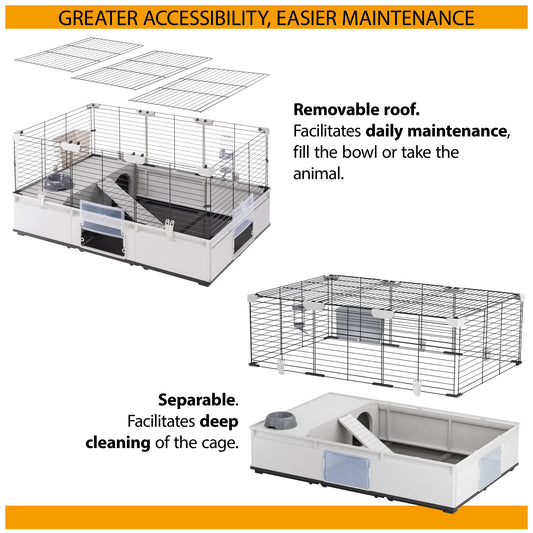Cats are fascinating creatures with a rich and diverse range of behaviours. From their graceful movements to their unique vocalizations, cats communicate with us through their body language and behaviours. In this guide, we will explore cat behaviour, explaining why they do certain things and helping you understand your cat better. So, let's decode the language of cats and uncover the secrets behind their scratching, purring, and more.
Understanding Cat Body Language
Tail Language:
A cat's tail is a vital communication tool. A high-held and gently curved tail signals a content and friendly cat.
If your cat's tail is twitching or flicking, it could indicate excitement or annoyance. A puffed-up tail is a clear sign of fear or aggression. Pay attention to the position and movement of your cat's tail to understand their emotions better.
Ear Positions:
Cats' ears are incredibly expressive and can reveal a lot about their mood. Forward-facing ears indicate alertness and curiosity, while flattened ears suggest fear or aggression. Half-raised ears can indicate relaxation or contentment. Observe your cat's ear positions to gauge their emotional state and respond accordingly.
Pupil Dilation:
The size of a cat's pupils can provide valuable insights into their emotional state. Dilated pupils usually indicate excitement, fear, or aggression. In contrast, constricted pupils may signal contentment or focus.
Please note that the lighting conditions can also influence pupil size. Understanding your cat's pupil dilation can help you interpret their current mood.
Exploring Common Cat Behaviours
Scratching:
Scratching is a natural behaviour for cats that serves multiple purposes. It helps them stretch their muscles, mark their territory, and keep their claws in optimal condition. To redirect your cat's scratching behaviour, provide appropriate scratching posts or pads in areas they frequent. Encourage and reward cats for using scratching posts, and discourage them from scratching furniture by using deterrents and positive reinforcement.
Purring:
Cats often associate purring with contentment and relaxation. Cats may purr when they're receiving affection, resting, enjoying your company or feeling comfortable. However, cats may also purr when they're in pain, anxious, or seeking comfort.
Cats often purr to communicate. To understand the meaning behind your cat's purring, observe other body language cues such as relaxed muscles, half-closed eyes, and an overall calm disposition.
Kneading:
Kneading is a behaviour where cats rhythmically push their paws against a soft surface, often accompanied by a kneading motion of their front paws. This behaviour is believed to be a throwback to their kittenhood when they kneaded their mother's abdomen to stimulate milk flow while nursing. Kneading is usually a sign of comfort, contentment, and a strong bond with their human. Provide a cozy spot for your cat to knead, such as a soft blanket or a plush bed.
Chattering:
Have you ever heard your cat make a rapid, chattering sound while watching birds or other prey through a window? If so, then you've witnessed the behaviour known as chattering.
People believe that a cat expresses frustration or excitement when it cannot reach its target. Some experts speculate that it mimics the sounds of prey to practice hunting techniques. Although the exact meaning is not fully understood, chattering is a common behaviour among cats and should be seen as a natural instinct.
Hissing and Growling:
Hissing and growling are defensive behaviours used by cats to communicate fear or aggression. When confronted with a perceived threat, a cat may hiss, growl, or arch their back to appear larger and more intimidating. These behaviours are warning signs and indicate that your cat feels threatened or unsafe. It's important to give your fearful cat space and time to calm down in these situations and seek professional guidance if aggressive behaviours persist.
Tail Wagging:
While dogs commonly wag their tails, cats may also wag their tails. In cats, vigorous tail wagging often suggests agitation or annoyance. It can be a sign that your cat is feeling stressed, upset, or in an aggressive state. However, it's important to assess other body language cues in conjunction with tail wagging to accurately interpret your cat's emotions.
Bringing Gifts:
It's not uncommon for cats to present their owners with small prey, such as birds, mice, or insects. This behaviour is their way of sharing their hunting success or displaying their natural hunting prowess. While it may seem unsavory to us, it's a sign of affection and a testament to their bond with you. Acknowledge the gesture without scolding or punishing your cat, as it's their instinctual behaviour.
Understanding cat behaviour is key to nurturing a strong and harmonious relationship with your feline companion. By observing their body language and interpreting their actions, you can respond appropriately and create a nurturing environment for your cat.
Each behaviour carries its unique meaning and helps us better understand their emotions and needs. Remember to consider your cat's individual personality and preferences, as not all cats exhibit behaviours in the same way. If you have concerns about specific behaviours or need further guidance, consult with a veterinarian or feline behaviourist for professional advice. Embrace the world of cat behaviour, cherish your furry friend's unique traits, and enjoy the special bond you share.
If you enjoyed this article, why not read:









